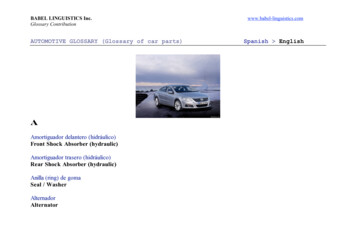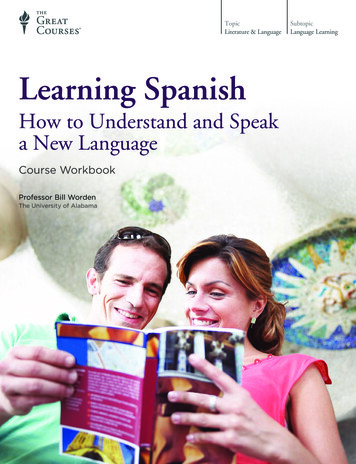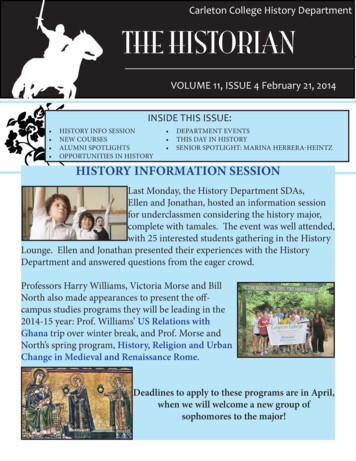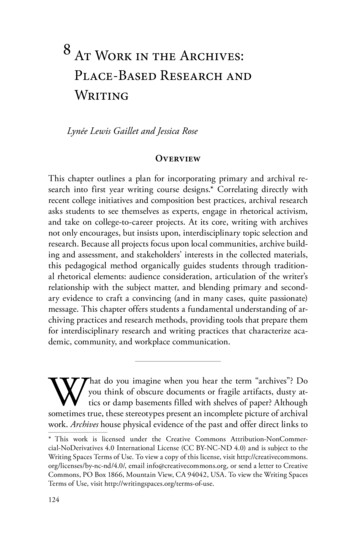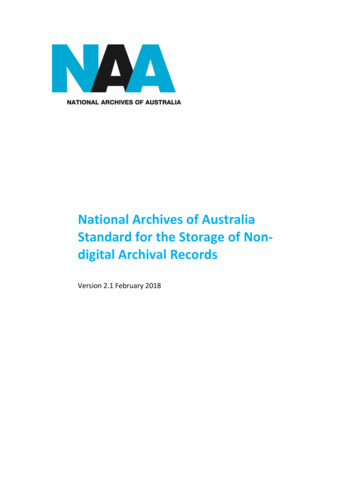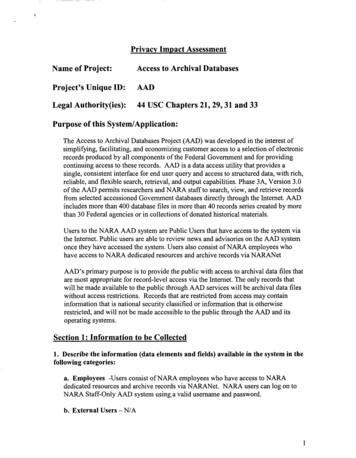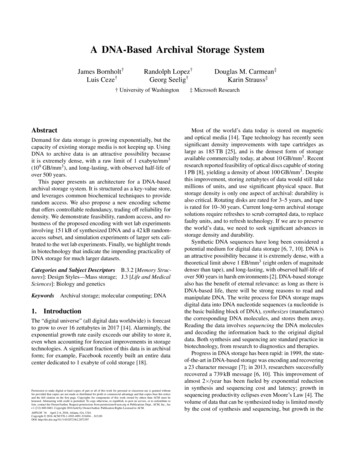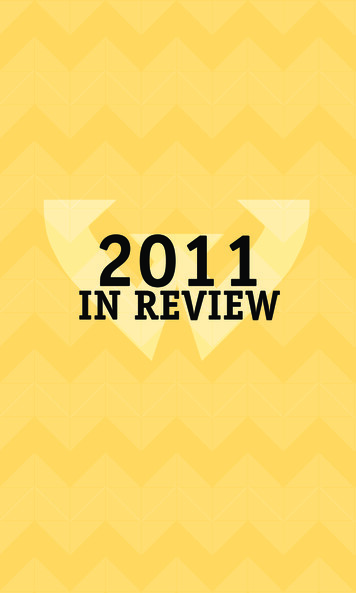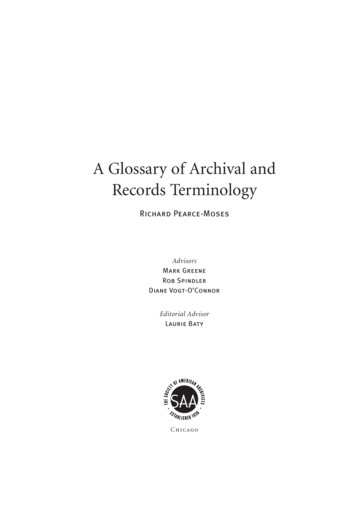
Transcription
AFS Gloss 01 fm7/25/0510:00 PMPage iiiA Glossary of Archival andRecords TerminologyRichard Pearce-MosesAdvisorsMark GreeneRob SpindlerDiane Vogt-O’ConnorEditorial AdvisorLaurie BatyChicago
GlossaryPage ivThe Society of American Archivists S. Wells Street, th FloorChicago, IL usa - Fax - www.archivists.org by the Society of American Archivists.All Rights Reserved.Library of Congress Cataloging-in-Publication DataPearce-Moses, Richard.A glossary of archival and records terminology / Richard Pearce-Moses.p. cm. -- (Archival fundamentals series. II)Includes bibliographical references.ISBN 1-931666-14-81. Archives--Terminology. 2. Records--Management--Terminology.I. Title. II. Series.CD945.P43 2005027'.0014--dc222005051613Graphic design by Matt Dufek, dufekdesign@yahoo.com.Fonts: Minion (text and footnotes); Meta (secondary text and captions).A Glossary of Archival and Records Terminology is online atwww.archivists.org/glossary.
AFS Gloss 01 fm7/25/0510:00 PMPage vT a b l e of C o n t e n t sPreface to the Archival Fundamentals Series II viiAcknowledgments xiThe Archival Lexicon xiiiIntroduction xxiiiKey to the Entries xxivCorrections and Revisions xxixA Glossary of Archival andRecords Terminology Bibliography
AFS Gloss 01 fm7/25/0510:00 PMPage vi
AFS Gloss 01 fm7/25/0510:00 PMPage viiPreface to theArchival Fundamentals Series IIThere was a time when individuals entering the archival professioncould read a few texts, peruse some journals, attend a workshop andinstitute or two, and walk away with a sense that they grasped thefield’s knowledge and discipline. This was an inadequate perception,of course, but it was true that the publications—basic or advanced,practical or theoretical—were modest in number.The archival world has changed considerably since these morequiet times. A rich monographic research literature is developing.Scholars from far outside the field are examining the “archive” andthe “record.” Archives, archivists, records, and records managers arein the daily news as cases appear testing government and corporateaccountability, organizational and societal memory, and the natureof documentary evidence—all challenging basic archival work andknowledge.The new edition of the Archival Fundamentals Series (AFS II) isintended to provide the basic foundation for modern archival practiceand theory. The original preface (written by Mary Jo Pugh in hercapacity as the series editor) to the first editions, which were publishedin the early to mid- s by the Society of American Archivists (SAA),argued that the seven volumes “have been conceived and written tobe a foundation for modern archival theory and practice” and aimedat “archivists, general practitioners and specialists alike, who are performing a wide range of archival duties in all types of archival and
AFS Gloss 01 fm7/25/0510:00 PMPage viiiviii A G l o s s a ry o f A rch iva l a n d R e c o rd s Ter m i n o l o g ymanuscript repositories.” It is hard to state the purpose of the newAFS editions better.There are some differences, both subtle and obvious, in the newvolumes. The new editions are more open-ended than earlier versions,extending back to the Basic Manual Series published a quarter-of-acentury ago by SAA, reflecting evolving viewpoints about archivaltheory and practice. Even more important a difference is the broaderand deeper context of archival publishing AFS volumes reside in.Mary Jo Pugh, in her introduction of just a decade ago, noted that theafs titles are companions to “more specialized manuals also availablefrom SAA.” Now, SAA has four other series (some just underway),including Archival Classics (featuring reprints or new collections ofolder publications with pivotal importance to the profession),Archival Readers (both collections of new and previously publishedessays intended to supplement the descriptions of foundational theoryand practice of the AFS II volumes), International Archival StudiesReaders (both collections of new and previously published essaysintended to provide glimpses of archival work and knowledge outsideof North America), and Archival Cases and Case Studies (examiningarchival work in a variety of institutional types and with a variety ofmedia). Added to SAA’s own publications is a vast sea of new titlespouring from the presses of other professional associations and trade,professional, and university publishers.Both the earlier Basic Manual Series and the Archival FundamentalsSeries provide benchmarks in the development of archival knowledgeand work. One can trace changing ideas and practices about archivalreference services by reading the , , and volumes dedicated to this subject in the respective SAA manual series. One alsoexpects to find in this volume current standards and consensus aboutthis aspect of archival work. One also expects now, of course, thatsome may disagree with aspects of the current presentation, and maypoint to the growing research and case study literature being generatedby the archival profession.Many people participated in the production of the various volumes constituting the Archival Fundamentals Series II. The profession owes its gratitude not only to the authors, but to various chairsand members of the SAA Publications Board; Miriam Meislik, Photo
AFS Gloss 01 fm7/25/0510:00 PMPage ixPre face ixEditor for the series; the SAA Executive Directors, Susan Fox andNancy P. Beaumont; and especially to Teresa Brinati, SAA Director ofPublishing, whose good humor, organization, and steady commitment to a quality product helped keep the publishing of these andother SAA volumes on track.Richard J. CoxPublications EditorSociety of American Archivists
AFS Gloss 01 fm7/25/0510:00 PMPage x
AFS Gloss 01 fm7/25/0510:00 PMPage xiAcknowledgmentsMade Possible With Support FromArizona State Library, Archives and Public RecordsNational Historical Publications and Records AdministrationArchival Research Fellowship Programadministered by the Massachusetts Historical SocietyMark Greene of the American Heritage Center at the University ofWyoming, Diane Vogt-O’Connor of the National Archives andRecords Administration, and Rob Spindler of Arizona StateUniversity served as advisors, guided decisions about the work in general, and reviewed definitions. Over the years and during this projectthey taught me as much about what it means to be a professional asanything else. I am humbled by their knowledge, generosity, support,and friendship.Laurie Baty served as a masterful editorial advisor. Her carefulreading of the manuscript caught many problems that crept inbetween A and Z, including clarifying definitions, fixing awkward language, and catching typos. Mark Longley once again proved his skillas a careful, thoughtful, and patient editor. His knowledge of technical writing has made the language of the glossary much cleaner.
AFS Gloss 01 fm7/25/0510:00 PMPage xiixii A G l o s s a ry o f A rch iva l a n d R e c o rd s Ter m i n o l o g yDiane Vogt-O’Connor was supported in her review of the definitions by Lew Bellardo, who co-authored the second edition, and byseveral others at the National Archives and Records Administration. Iam grateful for the many comments during the review process sent byLeon Miller, Geoffrey Huth, Ken Thibodeau, Barry Cahill, JohnGervais, Ala Rekrut, and Rebecca Remington.I am grateful to the National Historical Publications and RecordsCommission, the staff of the Massachusetts Historical Society, and tothose others involved in the archival research fellowships for theopportunity to spend some time thinking about the language ofarchives.I would also like to give special thanks to two individuals for theirsupport of this work. GladysAnn Wells, Director of the Arizona StateLibrary and Archives, made it possible for me to undertake this project and provided additional support. She has been a mentor andhelped me be a better professional. My partner, Frank Loulan, hasbeen patient, encouraging, and his general, wonderful self when Ihave been more than a little consumed in words. He has helped makeme a better person.
AFS Gloss 01 fm7/25/0510:00 PMPage xiiiThe Archival LexiconWords are, of course, the most powerful drug used by mankind.—Rudyard KiplingJargon—the specific use of certain terms—defines and distinguishesa profession. As the Bellardos noted in their preface to their 1992 glossary, “terminology serves to mark the current limits of professionalconcerns and responsibilities.”1 Since the publication of the Bellardos’glossary, the archival profession has experienced profound changesthat warrant a reassessment of those limits.Over the last ten years, academics and practitioners refined andrearticulated core archival concepts. Writings about appraisal introduced many new terms, including macro appraisal, functional analysis, and context analysis. Encoded archival description, a revolutionarychange in a fundamental archival function, incorporated a number oftechnical terms such as DTD and XML into the archival lexicon, andelaborated concepts such as archival cataloging and finding aid.Possibly the most significant impact on archival language andprofessional boundaries resulted from the challenges of electronicrecords. E-records forced archivists into collaborations with differentdisciplines. In response, archivists adopted terms from informationtechnology, publishing, and knowledge management. They began to1. Lewis J. Bellardo and Lynn Lady Bellardo, A Glossary for Archivists, Manuscript Curators, andRecords Managers (Society of American Archivists, 1992), p. v.
AFS Gloss 01 fm7/25/0510:00 PMPage xivxiv A G l o s s a ry o f A rch iva l a n d R e c o rd s Ter m i n o l o g ygrapple with born-digital documents and to become familiar witharcane aspects of technology used to record and authenticate electronic documents, such as ciphers, encryption keys, and encodingschemes. At the same time, other professions adopted—sometimesappropriated—archival terms. The very word that identifies the profession, archives, took on the meaning of offline storage and backup.I believe that, at a fundamental level, the basic concepts of recordsand recordkeeping are not antiquated. They remain vital and important. However, the language of records is often tied to a paper realm,emphasizing physical qualities over functional characteristics. Thechallenge is to rearticulate the essential characteristics of those concepts in terms that make sense in a vastly different environment.Samuel Johnson believed that one of the lexicographer’s jobs was “tocorrect or proscribe . . . improprieties and absurdities.” However,Johnson also believed that a dictionary should “register the language. . . ; not [to] teach men how they should think, but relate how theyhave hitherto expressed their thoughts.”2The Society of American Archivists’ first glossary was founded onthe “conviction that professionalism demands precision, which in turnimplies standardization” and presented “the preferred term and meaning in each case.”3 The Bellardos continued that practice, noting thatthey “identified preferred terms and developed definitions reflectingthe practices of leading archival institutions and professionals.”4While the first two editions were prescriptive, this glossary isdescriptive. Rather than serving as an arbiter of correctness, it documents the different ways a term is used within and outside the profession. It is founded on the lexicographical principle of corpus linguistics. The definitions are not based on an ideal, theoretical model,but on how the words are used in the literature. While researching thisglossary, I compiled a database containing more than 6,300 citations2. Cited in Sidney Landau, Dictionaries: The Art and Craft of Lexicography – 2nd ed.(Cambridge University Press, 2001), p. 62.3. “A Basic Glossary for Archivists, Manuscript Curators, and Records Managers,” reprintedfrom The American Archivist 37:3 (July 1974), pp. 415–433. Citation, p. 415.4. p. v.
AFS Gloss 01 fm7/25/0510:00 PMPage xvThe Archival Lex icon xvfrom more than 500 sources.5 Those sources included glossaries,monographs, and articles from the fields of archives, records management, libraries, preservation, bookbinding, computing, and law.Many terms have meanings that differ between communities ofinterest or disciplines; ‘record’ has senses that are specific to cataloging, to computing, and to law. Even within the community ofarchivists, meanings vary. For example, some archivists carefully distinguish archives from personal papers, but others do not. Some ofthese differences are significant, others are slight. The variationsunderscore a lack of professional consensus. As a result, the glossarypoints out horizons of understanding, where key concepts are beingreconsidered or established. A single definition for a term could easily confuse a reader who is confronted with a text that uses that termwith a very different meaning.Many words were charged with considerable discussion in theprofessional literature and were the subject of flame wars on Internetdiscussion groups. Even though the glossary was not intended to beprescriptive, reporting differing senses necessarily drew intellectuallines in the sand. Teasing meaning from polemics was a bit like walking on a mine field. I often heard in my head renowned archivistschallenging me to prefer their particular point of view. It would havebeen a lot easier to ignore those voices if I did not have a great deal ofrespect for them.A significant temptation that lexicographers face is a desire tonormalize the language, to make it more rational. In its most innocentform, that temptation is a compulsion to tidy up those areas of ambiguity around the details of meaning, to correct the exception by making some irregularity in the language fit the mold. A darker side ofnormalization is for the lexicographer to intentionally interject biasinto the work by preferring one definition over another, often in deference to a personal point of view.5. The Bibliography is limited to those works cited in the Glossary. A more perfect glossarywould have been based on a corpus that allowed a sophisticated analysis of a much largerand more diverse body of archival literature. Given the resources at hand, I built the corpusmanually by reading many of those works and transcribing salient citations into a database.To complement that work, I also searched for citations from the Internet. Google was particularly useful to determine the more common form among variants because it reports thenumber of times the word or phrase appears in its database. For example, it reported 15,100occurrences for archival science, but only 3,470 for archives science.
AFS Gloss 01 fm7/25/0510:00 PMPage xvixvi A G l o s s a ry o f A rch iva l a n d R e c o rd s Ter m i n o l o g yHilary Jenkinson provides an excellent example of normalizationwhen he synthesizes a definition of archives in his Manual.6 Not satisfied with the definition in the Oxford English Dictionary, he constructs his own “by comparing in some well-known case documentswhich are obviously Archives with others which are obviously not.”7However, another person in another situation could just as legitimately select different examples and wind up with a very differentdefinition. For example, having begun my career some sixty yearsafter Jenkinson published his Manual and having worked primarilywith photographic archives and local history collections in the UnitedStates, I found Jenkinson’s definition archaic, alien, and artificial. Thefoundation of Jenkinson’s definition does not fit my experience, sofrom my perspective his logic falls apart.The issue is not right or wrong, but rather language’s irregularnature. Different people can impose or discern different orders onlanguage. Language is ad hoc, not de jure. A word’s meaning is derivedfrom its use, not from a rational system. Answering Juliet’s question,linguist Stephen Pinker observesWhat’s in a name is that everyone in a language community tacitly agrees touse a particular sound to convey a particular idea. Although the word rosedoes not smell sweet or have thorns, we can use it to convey the idea of arose because all of us have learned, at our mother’s knee or in the playground, the same link between a noise and a thought.8The difficulty is that individuals in the community have smelledroses with different colors. They may agree on the idea in general, butnot in particular. This point was driven home for me when one particular sentence in a draft paper I was reading threw me into high dudgeon.With more and more information now created in electronic, rather than physical form, records may need to be re-defined for an electronic medium. . . .With some incredulity I pondered, Who was going to redefine‘record’? The passive voice masks a presumption that the active voicewould have underscored; if the authors rewrote the sentence in the6. Hilary Jenkinson, A Manual of Archive Administration (Percy Lund, Humphries, 1966), p. 2 - 15.7. p. 3.8. Words and Rules, p. 2.
AFS Gloss 01 fm7/25/0510:00 PMPage xviiThe Archival Lex icon xviiactive voice, who would they expect to provide the new definition?There is no authority that establishes definitions for English words.Language evolves. It is not constructed. My goal has been to document the former, and to avoid the presumption of the latter.Language is largely transparent. Words surround us like air, and weare usually oblivious to them. Only when there is some disturbancedo we take notice. Words are so familiar that most people would behard-pressed to define them with any precision. While working onthis project, I asked a group of well-respected archivists to come upwith a definition for record by listing essential characteristics. Theystumbled, some of which was a function of their being caught offguard. Before I began this project I could not clearly and succinctlydescribe the characteristics of a record, and I could not have answeredthe question well. Only by paying careful attention to the contexts inwhich the words were used could I begin to get sufficient perspectiveto perceive the nuances of meaning.Professions use some words as shorthand. Jargon used within aprofessional context where it is understood is a handy shortcut. Usingthe language outside that community is often confusing.Unfortunately, people overly concerned with intellectual trendinessoften adopt hot new jargon—buzzwords—without quite knowingwhat those words mean. Bruce Handy wondered about the use of theword ‘postmodern’. Why would editors at Elle describe a ski parka aspostmodern? To find out, he contacted several authors who had usedthe term in odd contexts. He concluded that ‘postmodern’ hadbecome “culturespeak, short for Stuff That’s Cool in 1988. It’s the current version of groovy—except that using it makes you sound smart.”9Individuals with no desire to be trendy may similarly abuse language. Henry Fowler described cant as “insincere or parrotlike appealto principles, religious, political, or scientific, that the speaker doesnot believe in or act upon, or does not understand.”10 Staff at the9. “The Rise and Fall of a Great American Buzzword,” Spy (April 1988).10. H. W. Fowler, Modern English Usage – 2nd ed., revised and edited by Sir Ernest Gowers(Oxford University Press, 1965), p. 315.
AFS Gloss 01 fm7/25/0510:00 PMPage xviiixviii A G l o s s a ry o f A rch iva l a n d R e c o rd s Ter m i n o l o g yNational Endowment for the Humanities use the phrase ‘magicwords’ instead of ‘cant’. These magic words often appear in grantapplications because applicants think grant reviewers want to hearthem. Unfortunately, their use of the words makes it clear that they donot understand them. For example, an applicant may promise thatfinding aids will be in MARC format because they know that MARChas something to do with description and is a standard reviewers lookfor. Unfortunately, the sample finding aid attached to the applicationclearly has nothing to do with MARC.In the archival community, buzzwords and magic words include‘evidence’, ‘digital object’, ‘resource’, ‘metadata’, ‘trustworthy’, and thephrase ‘authentic and reliable.’ The more archivists work with othercommunities, the more they must take the time—and words—to fullyexplain these concepts. They must take the time to learn other communities’ specialized language, and to express archival ideas and concerns in those terms.The issue is not purity of language. Jargon, used within a professional context, is a handy shortcut because its meaning is clear andoften carries nuances that allow for succinct expression. Buzzwordsoften point to important developments, and the meaning shifts as thething it refers to evolves. However, people often use jargon as fillerwords, resulting in sloppy language that reflects sloppy thinking.In the end, words are slippery. Meaning is elusive. Language is clearonly when there is nothing to argue about. We are faced with a viciouscircle. As our understanding of ideas changes, so do the meanings ofthe words we use to represent those ideas.Writing the glossary has helped me understand and engage in thelarger dialog of the archival profession. It forced me to think about thewords more carefully and, in Frank Burke’s terms, more theoreticallyabout the profession.11John Roberts summarized archivy in eleven words, “We save whatis historically valuable—there; that is the theory.”12 Where Roberts11. “Future Course of Archival Theory,” American Archivist 49:3 (Summer 1986): 40–46.12. “Archival Theory: Much Ado about Shelving,” American Archivist 50:1 (Winter 1987): 66–74.
AFS Gloss 01 fm7/25/0510:00 PMPage xixThe Archival Lex icon xixsees simplicity, I see confusion and complexity. Roberts sees reflectionas so much useless navel gazing. I see many questions surroundingalmost every word in his statement. The first question Roberts’ statement raises is, Who is the ‘we’?In context, it is clear that he is referring to archivists. In the ageof electronic records, it will take more than archivists to preserve records. They must partner with information technologists and others, and those collaborations will blur the boundaries of who is an archivist. ‘Save’ raises the question of how the process of saving recordshas changed. Because the process of migrating records to avoidtechnological obsolescence often results in changes to therecords, we must think about how records’ reliability is affected. ‘What’ refers to the object of this process. Dynamic information systems, hyperdocuments, and virtual reality challengeour understanding of recordness. Roberts’ final phrase ‘historically valuable’ side-steps any number of questions. What is valuable? To whom? For what purpose?Roberts’ statement becomes more complex when I consider notwhat the words mean, but the why underlying the words. How Iunderstand those questions has an immediate, practical impact onhow I do my job. I do not think the questions have answers, per se.Like words and definitions, the questions and how they are understood will change over time and in different situations.Even though the language of archives and recordkeeping hasevolved over the centuries, the fundamental function and essentialcharacteristics of a record remain the same. Society has long needed away to fix memory for future reference, and that need has not goneaway. We must come to understand how people are using new formsof records. Archivists are, in my mind, uniquely qualified to considerhow the characteristics of those new forms map to established characteristics and the significance of new ones.
AFS Gloss 01 fm7/25/0510:00 PMPage xxxx A G l o s s a ry o f A rch iva l a n d R e c o rd s Ter m i n o l o g yIn a paper environment, records were an unintended by-product ofother activities; records just happened. At the University of Texas,Harry Ransom built his reputation by collecting the many drafts ofauthors’ works; he saw those drafts as evidence of the creative processthat gave a richer understanding of the final work. In the digital environment, records don’t just happen. With word processing, many—ifnot most—of the drafts Ransom would have wanted are lost. Eachtime a document is opened, revised, then saved, the previous versiondisappears unless consciously preserved. Few database systems aredesigned to be able to roll back data so that it is possible to see thestate of the data at any given point in the past; data is added, changed,and deleted, with no thought to preserving older data for future reference. The challenge of paper documents is an excess of irrelevantmemory captured in piles of paper. The challenge of electronicrecords is incremental amnesia.While the language and practice of recordkeeping has changed,the work of archivists and records professionals remains fundamentally the same. I believe—and this is not a novel concept—that thecharacter of our profession must change. Archivists have often beenseen as custodians of the past. We are seen as the keepers of old things.While we will remain the custodians of old records, we must changeour emphasis from the preservation of culture as a thing of the past.We must become advocates for future users of current information byensuring the transmission of culture. What of the present needs to beremembered for future users? I believe that our knowledge of whathas enduring value and of how researchers use materials is our distinguishing expertise. It is that knowledge that can enable us to helprecords creators know when to commit intentional acts of memory, toknow what to save. To do that, we must be able to speak clearly.Some of the more animated discussions with my advisors revolvedaround words that I found personally interesting, but which are of limited value to the audience. Sometimes I thought a word, such as eschatacol, was fascinating precisely because it was arcane. Many times Ifound that the word—and its underlying meaning—captured a piece
AFS Gloss 01 fm7/25/0510:00 PMPage xxiThe Archival Lex icon xxiof the profession’s history and provided context for and insight intocurrent practice. JoAnne Yates’ Control Through Communication13 wasa valuable source of terms from the nineteenth and early twentiethcenturies. Those words, based in paper records, gave me significantinsights into how people used paper records to solve problems in thepast, and from that I gained a better understanding of parallel problems in the digital present. One reason I favored including those termswas that I saw modern parallels. Ars dictaminis, manuals of letter writing with established forms that could be used as boilerplate, persisttoday under other names, and some word processing programs comewith canned text that are, in my mind, equivalent.Ultimately, this particular glossary is a work of autobiography.The selection of words and their definitions reflects my own careerand interests. While I sought to be as objective as possible, workingwith advisors, seeking others’ opinions, and justifying definitions withcitations from the literature, the work will ultimately be a reflection ofme. Another person would have written another glossary.13. (Johns Hopkins University Press, 1989).
AFS Gloss 01 fm7/25/0510:00 PMPage xxii
AFS Gloss 01 fm7/25/0510:00 PMPage xxiiiIntroductionThe first two editions of the glossary were, from their titles, “forarchivists, manuscript curators, and records managers.” This glossarytargets a wider audience of anyone who needs to understand recordsbecause they work with them. It attempts to build a bridge betweenrecords, information technology, and business communities by interpreting archival concepts for people in other disciplines, while at thesame time explaining those other disciplines to archivists and recordsprofessionals.This glossary is based primarily on archival literature in theUnited States and Canada, in that order. In a few instances, terms, definitions, and citations from other English-speaking communities areincluded when relevant. This glossary includes terms that relate to thetypes of records that someone is likely to encounter when readingarchival literature or when working with a fairly typical collection ofrecords, and it emphasizes terms relating to electronic records. It alsoincorporates terms from the literature of preservation, law, andmicrographics, as well as common form and genre terms from architectural and technical drawings, motion picture and video, photography, and sound recording. It includes some words that are no longerin common use, but which are useful when reading older literature;for example, Spindex. The glossary does not include many words specific to affiliated professions, such as rare books or printing.In general, words with no archival connotation were excluded.While aisles are common in archives, any good dictionary will provide
AFS Gloss 01 fm7/25/0510:00 PMPage xxivxxiv A G l o s s a ry o f A rch iva l a n d R e c o rd s Ter m i n o l o g yan adequate definition of the term. A few entries are common wordsor phrases which function as guide terms to illustrate the relationships between other terms. For example, box needs no definition butis included as a bucket term to group cross-references to relatedterms, such as Hollinger box, Bankers Box, and phase box. Similarly,the phrase ‘preservation methods and techniques’ is used to point toother entries scattered throughout the alphabet.The glossary contains more than 2,000 defined entries and morethan 600 lead-in terms, and nearly 700 citations from some 280sources. Some 2,500 cross-references (not counting lead-in terms) inthe syndetic structure illustrate relationships between terms.Ke y to the Ent r iesheading, part ofspeech, variants,and definitionindex, n. (indexes, indices, pl.) 1. An ordered list of headingsthat points to relevant in
umes constituting the Archival Fundamentals Series II. The profes-sion owes its gratitude not only to the authors, but to various chairs and members of the SAA Publications Board; Miriam Meislik, Photo AFS_Gloss_01_fm 7/25/05 10:00 PM Page viii
